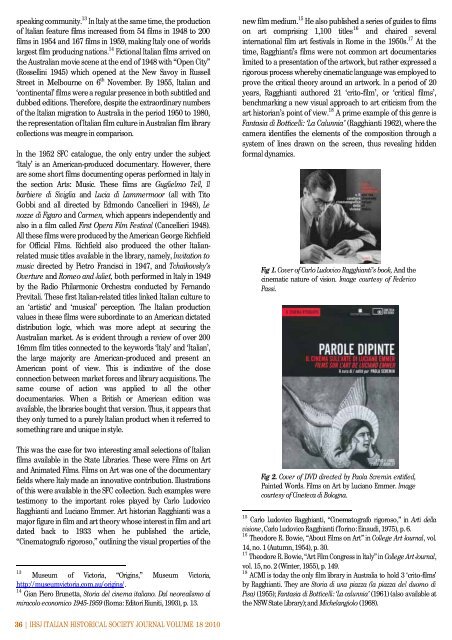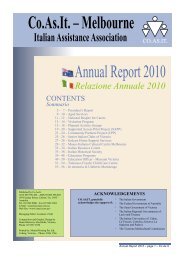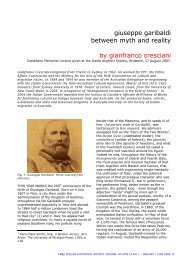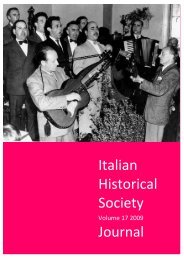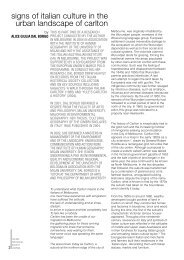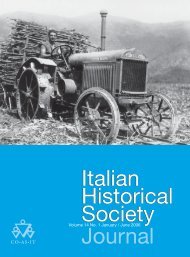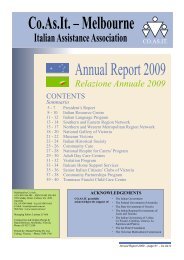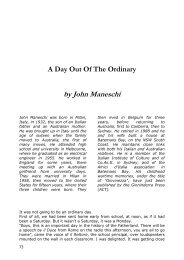January-December 2010, vol. 1
January-December 2010, vol. 1
January-December 2010, vol. 1
- No tags were found...
You also want an ePaper? Increase the reach of your titles
YUMPU automatically turns print PDFs into web optimized ePapers that Google loves.
speaking community. 13 In Italy at the same time, the productionof Italian feature films increased from 54 films in 1948 to 200films in 1954 and 167 films in 1959, making Italy one of worldslargest film producing nations. 14 Fictional Italian films arrived onthe Australian movie scene at the end of 1948 with “Open City”(Rossellini 1945) which opened at the New Savoy in RussellStreet in Melbourne on 6 th November. By 1955, Italian and‘continental’ films were a regular presence in both subtitled anddubbed editions. Therefore, despite the extraordinary numbersof the Italian migration to Australia in the period 1950 to 1980,the representation of Italian film culture in Australian film librarycollections was meagre in comparison.In the 1952 SFC catalogue, the only entry under the subject‘Italy’ is an American-produced documentary. However, thereare some short films documenting operas performed in Italy inthe section Arts: Music. These films are Guglielmo Tell, Ilbarbiere di Siviglia and Lucia di Lammermoor (all with TitoGobbi and all directed by Edmondo Cancellieri in 1948), Lenozze di Figaro and Carmen, which appears independently andalso in a film called First Opera Film Festival (Cancellieri 1948).All these films were produced by the American George Richfieldfor Official Films. Richfield also produced the other Italianrelatedmusic titles available in the library, namely, Invitation tomusic directed by Pietro Francisci in 1947, and Tchaikovsky’sOverture and Romeo and Juliet, both performed in Italy in 1949by the Radio Philarmonic Orchestra conducted by FernandoPrevitali. These first Italian-related titles linked Italian culture toan ‘artistic’ and ‘musical’ perception. The Italian productionvalues in these films were subordinate to an American dictateddistribution logic, which was more adept at securing theAustralian market. As is evident through a review of over 20016mm film titles connected to the keywords ‘Italy’ and ‘Italian’,the large majority are American-produced and present anAmerican point of view. This is indicative of the closeconnection between market forces and library acquisitions. Thesame course of action was applied to all the otherdocumentaries. When a British or American edition wasavailable, the libraries bought that version. Thus, it appears thatthey only turned to a purely Italian product when it referred tosomething rare and unique in style.This was the case for two interesting small selections of Italianfilms available in the State Libraries. These were Films on Artand Animated Films. Films on Art was one of the documentaryfields where Italy made an innovative contribution. Illustrationsof this were available in the SFC collection. Such examples weretestimony to the important roles played by Carlo LudovicoRagghianti and Luciano Emmer. Art historian Ragghianti was amajor figure in film and art theory whose interest in film and artdated back to 1933 when he published the article,“Cinematografo rigoroso,” outlining the visual properties of the13Museum of Victoria, “Origins,” Museum Victoria,http://museumvictoria.com.au/origins/.14 Gian Piero Brunetta, Storia del cinema italiano. Dal neorealismo almiracolo economico 1945-1959 (Roma: Editori Riuniti, 1993), p. 13.new film medium. 15 He also published a series of guides to filmson art comprising 1,100 titles 16 and chaired severalinternational film art festivals in Rome in the 1950s. 17 At thetime, Ragghianti’s films were not common art documentarieslimited to a presentation of the artwork, but rather expressed arigorous process whereby cinematic language was employed toprove the critical theory around an artwork. In a period of 20years, Ragghianti authored 21 ‘crito-film’, or ‘critical films’,benchmarking a new visual approach to art criticism from theart historian’s point of view. 18 A prime example of this genre isFantasia di Botticelli: ‘La Calunnia’ (Ragghianti 1962), where thecamera identifies the elements of the composition through asystem of lines drawn on the screen, thus revealing hiddenformal dynamics.Fig 1. Cover of Carlo Ludovico Ragghianti’s book, And thecinematic nature of vision. Image courtesy of FedericoPassi.Fig 2. Cover of DVD directed by Paola Scremin entitled,Painted Words. Films on Art by Luciano Emmer. Imagecourtesy of Cineteca di Bologna.15 Carlo Ludovico Ragghianti, “Cinematografo rigoroso,” in Arti dellavisione, Carlo Ludovico Ragghianti (Torino: Einaudi, 1975), p. 6.16 Theodore R. Bowie, “About Films on Art” in College Art Journal, <strong>vol</strong>.14, no. 1 (Autumn, 1954), p. 30.17 Theodore R. Bowie, “Art Film Congress in Italy” in College Art Journal,<strong>vol</strong>. 15, no. 2 (Winter, 1955), p. 149.18 ACMI is today the only film library in Australia to hold 3 ‘crito-films’by Ragghianti. They are Storia di una piazza (la piazza del duomo diPisa) (1955); Fantasia di Botticelli: ‘La calunnia’ (1961) (also available atthe NSW State Library); and Michelangiolo (1968).36 | IHSJ ITALIAN HISTORICAL SOCIETY JOURNAL VOLUME 18 <strong>2010</strong>


